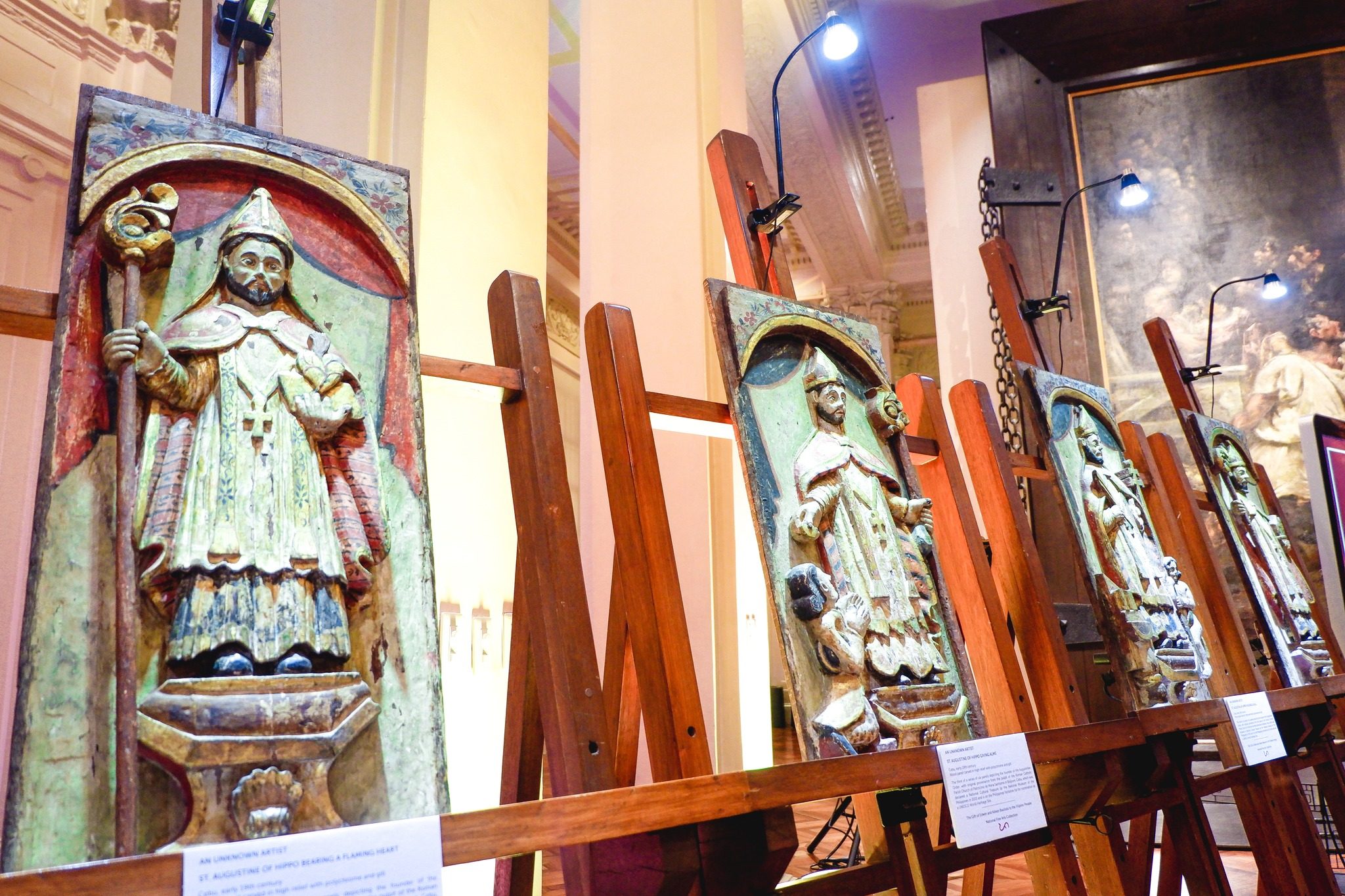SUMMARY
This is AI generated summarization, which may have errors. For context, always refer to the full article.

How did panels stolen in the late 1980s from the pulpit of the heritage church of Boljoon in southern Cebu end up decades later as a “Gift to the Nation” exhibit at the National Museum of the Philippines?
That is the question raised by many in Cebu after last week’s opening of the exhibit and donation by a private collector of four of the panels long thought lost by parishioners of the Archdiocesan Shrine of Patrocinio de Maria Santisima.
More than raising questions, people demanded their return to Boljoon, inundating Facebook posts of the National Museum and media organizations that reported the exhibit with repeated assertions that these were stolen and should be repatriated to Cebu.
This weekend, various people and groups in different parts of Cebu are working independently for its return. Boljoon Councilor Eva Lowela Villanueva Moraca is finalizing an ordinance asking for their return, that she plans to file on Monday, February 19. Boljoon Mayor Jojie Derama issued a call for its repatriation. Provincial Board Member Red Duterte of the 5th District is preparing a counterpart provincial resolution that he plans to put forward, also on Monday, with a privilege speech on the issue.
Last Friday, Cebu Governor Gwendolyn Garcia asked Capitol consultant for heritage and museums Dr. Jose Eleazar Bersales to look into the issue “so that we may formally take a position of formally requesting the National Museum to return these panels.” Garcia is preparing a letter to be sent to the National Museum.
Police in Boljoon are also going over their piles of police blotters to look for the report of the theft. One was filed, said retired policeman Archimedes Villanueva, 79, who was a patrolman in the town when the panels were stolen. Councilor Moraca is his daughter and will be assisting him in the filing of an affidavit to attest to his assertions to bolster the town’s claim.
The Cebu Archdiocesan Commission for the Cultural Heritage of the Church will meet on Monday to discuss the issue and submit recommendations to Cebu Archbishop Jose S. Palma on Tuesday.

A private collection
The commission was alerted to the existence of the panels last year by Orland James Romarate, who works for the Cebu City Cultural and Historical Affairs Office. Romarate was sent a video of an episode of Executive Class on ANC with host David Celdran interviewing private collector Edwin Bautista, president and CEO of Union Bank of the Philippines.
The video, uploaded to YouTube on November 25, 2023, showed the four panels for just 3 seconds but Romarate, who is from Boljoon, immediately knew these were the ones stolen from their church. He alerted the commission, whose members then negotiated quietly for its return to Cebu.
The exhibit and its publicity last week blew things up.
The panels were indeed stolen from Boljoon, said Fr. Brian Brigoli, chairperson of the commission. Brigoli said they have extensive documentation to prove that the four panels used to adorn the Boljoon pulpit.

Whether the panels were carted away by thieves, which Boljoon residents said was what happened, or sold by the parish priest, which was claimed by some online, it is still considered stolen property, said Brigoli. He said Catholic Church laws do not allow priests to sell parish properties.
Hazy recollections and resurfaced emotions
But the circumstances of the loss are obscured by hazy remembering of an event more than three decades in the past and colored by resurfaced emotions of a town that once stopped going to mass to ostracize a priest they accused of selling its antiques. That same priest then filed a case for slander against parishioners who were locked up through an arrest warrant enforced on a Friday. They crammed the detention cell, recalled heritage advocate and Boljoon Budget Officer Ronald Villanueva.
Interviewed separately, Villanueva, Moraca, and former journalist Iste Sesante Leopoldo also remember a “black mass” or “misa maldisyon” held at the church to curse those who stole parish antiques. Moraca and Leopoldo said they all wore black and only had candles for illumination during the mass held at 8 pm. A prominent local family had its members dying off shortly after, Moraca claimed.
Jonah John Rodriguez, executive director of the Cebu City Office on Substance Abuse Prevention, recalled the shock of townspeople upon the discovery that the panels were stolen. His family’s house is just outside the church compound.
“Natay-og baya ang tibuok Boljoon ato. Imagine one day pag abli sa simbahan, bakante na ang pulpito namo,” he said. (The entire Boljoon was shocked. Imagine that one day we just saw our pulpit already missing the panels.)

Rodriguez said he was in elementary school when this happened.
“It was painful and jarring” to see the empty space left by the panels, said heritage lawyer Kay Malilong. She said the space near the pulpit was her favorite spot at the church because there was an electric fan there.
“We all believed that the panels were stolen. The idea that the priest took them and sold them only happened now after the publicity surrounding that donation,” Malilong said.
“I know that the priest assigned at that time stayed on up to 1995 after the panels were gone. Had that been true, the townspeople would have done everything to make that priest suffer but he was still welcome. People still continued going to church, unlike in the early 80s when they really accused the priest of selling off antiques and they stopped going to church because I remember we went to church in Caceres,” Malilong said.
She questioned why the burden should be placed on Boljoon to prove the items were stolen.
“Why should we prioritize the feelings of the donors of sacred objects with questionable provenance? Nganong kami na man ang mu prove nga gikawat na nga? They should have checked because the duty of due diligence belongs to the National Museum and they’re the government agency, not us,” she said. (Why should we be the one to prove it was stolen?)
Repatriating the panels
“Ma-uli ra lagi na (Those panels will be returned),” said Fr. Milan Ted Torralba, executive secretary of the Catholic Bishops’ Conference of the Philippines’ (CBCP) Episcopal Commission for the Cultural Heritage of the Church.
Torralba said there is a process to the repatriation of items, even those considered stolen. He said that in his previous discussions with National Museum Director Jeremy Barns, unrelated to this case, the latter was generally in favor of repatriation.
Rappler sent emails with questions and requests for an interview with Barns to the National Museum last Thursday and Friday but did not receive a response.
Torralba said there is an existing agreement between the CBCP and the National Commission for Culture and the Arts (NCCA) on providing assistance in “retrieving lost and/or unlawfully taken cultural properties of the Church.”
It is an “articulation” of the agreement between the Holy See and the Philippine Government that took effect on May 29, 2008.
In his book, “The Pueblo of Bolhoon,” the late author Paul Gerschwiler described the pulpit as having “six rectangular recessed planes angled against each other, which once were decorated by beautifully carved and painted wooden relief-images.”
Only the panel that depicts St. Leo the Great wasn’t stolen. It has since been transferred to the parish museum. Gerschwiler described the other panels as depicting “Agustin de Hippo, San Cirilo de Alexandria and San Ambrosio de Milan.”
He wrote in the book, published by the Ramon Aboitiz Foundation, that these panels were “missing, looted and sold.”
With one panel in the parish museum and four at the National Museum, one is still unaccounted for, said Villanueva.
The parish had copies made and installed on the pulpit. These were then unveiled during the dedication of the altar last July 2019, he said.

The pulpit was where the priest would speak before modern sound systems were installed in churches. In Boljoon’s case, it is found on the epistle or right side of the church when facing the altar. It was acoustically designed to amplify a speaker’s voice.
Dr. Jocelyn Gerra said the panels are not just “the heritage of the church, this is the heritage of the people of Boljoon.”
“Now is a very good time in which churches and private persons or government institutions should really look into their assets, labi na ang (especially the) cultural heritage aspects,” said Gerra, a heritage advocate. She said what happened should trigger alarm bells because it is not isolated.
Villanueva said that if there was one good thing brought about by the resurfacing of the panels, it is that it has galvanized and united the Boljoon community in asking for its repatriation. – Rappler.com
1 comment
How does this make you feel?










This is a test of the strength of the donor’s political connections against that of the affected people of Boljoon, Cebu. If the latter cannot have the said “stolen” or “sold without authority” properties returned to them, they may conduct a second “misa maldisyon.” God will be the People of Boljoon’s last resort.